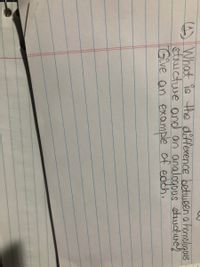
Human Anatomy & Physiology (11th Edition)
11th Edition
ISBN: 9780134580999
Author: Elaine N. Marieb, Katja N. Hoehn
Publisher: PEARSON
expand_more
expand_more
format_list_bulleted
Concept explainers
Question

Transcribed Image Text:() homologous
structure and an analogous etucture?
Give an example of edch.
What io the diffexence between a
Expert Solution
This question has been solved!
Explore an expertly crafted, step-by-step solution for a thorough understanding of key concepts.
Step by stepSolved in 2 steps

Knowledge Booster
Learn more about
Need a deep-dive on the concept behind this application? Look no further. Learn more about this topic, biology and related others by exploring similar questions and additional content below.Similar questions
- Each of the following three questions contains two lists. The first is a list of some characteristics of our own species, Homo sapiens, that distinguish it from LUCA. The second is a list of possible sequences (reading from left to right) in which these novelties were acquired by our ancestors during the course of human evolution. Choose the number of the correct sequence. If none is correct, choose "None of the above." Here is the first pair of lists: A. Bilateral symmetry B. Bony skeleton C. Mitochondria D. Notochord E. Multicellularity O D, E, B, A, C O C, E, A, D, B O E, C, A, D, B O A, E, C, D, B O None of the abovearrow_forward4) Repetitive DNA comprises about _________ of chromosomal DNA A) 5% B) 40% C) 60% D) 95%arrow_forward1.) I have attempted to make connections between these topics throughout the semester: the idea of multicellularity, complexity, pattern formation, signaling, embryonic development and postembryonic development. Discuss these ideas from simple organisms, like Dicty or Volvox to more complex organisms like insects and vertebrates. How are these ideas similar and how are they connected through evolution? Use examples from class. (20 Points, limit to 1 page) 2.) Early in this semester I introduced you to the concept of the developmental biology tool kit. Throughout the semester we have built upon that tool kit. A sample of your tool kit includes gene expression, morphogens, scaffolds, time, endocrine, nervous system, cell division, electromagnetic fields, migration, and cell adhesion. Using examples from embryology, regeneration and post embryonic development discuss the aforementioned tools. (20 Points, limit to 1 page) 3.) This picture depicts one of Weismann's contributions to…arrow_forward
- Which statement about the relationship between phenotypic and genetic attributes is correct? O a Usually phenotypically similar organisms are not genetically similar. O b Organisms with very similar morphology also have very similar genes. Genetically similar organisms can appear profoundly different morphologically. O d Analogous qualities among two species are similar due to shared ancestry.arrow_forward5c. What is wrong with this sentence “Humans are closely related to apes”?arrow_forwardDraw a structure of chromosomesarrow_forward
- Parallel evolution, convergent evolution and character state reversals are all examples of Select one: a. synapomorphy b. homoplasy c. homologyarrow_forwardWhat is the difference between similarity and homology?arrow_forwardMembers of two different species possess a similar-looking structure that they use in a similar way to perform about the same function. Which of the following would suggest that the relationship more likely represents homology instead of convergent evolution? a. The two species share many proteins in common, and the nucleotide sequences that code for these proteins are almost identicalb. The two species live at great distance from each otherc. The structures in adult members of both species are similar in sized. Both species are well adapted to their respective environmentsarrow_forward
- Polyploidy is very common in flowering plants: approximately 40% of all flowering plant species are polyploids. Although polyploidy exists in many different animal groups, it is much less common. Why is polyploidy more common in plants than in animals? Give one or more possible reasons.arrow_forwardFrom a cladistic perspective, in the phylogenetic tree shown above, the cartilaginous skeleton is a(an):A) apomorphyB) pleisiomorphyC) sympleisiomorphyD) synapomorphy 8. From a cladistic perspective, in the phylogenetic tree shown above, the bony skeleton is a(an):A) apomorphyB) pleisiomorphyC) sympleisiomorphyD) synapomorphyarrow_forwardWhich of the following would not be consistent with the ideathat a disorder has a genetic component?a. The disorder is more likely to occur among an affectedperson’s relatives than in the general population.b. The disorder can spread to individuals sharing similarenvironments.c. The disorder tends to develop at a characteristic age.d. A correlation is observed between the disorder and amutant gene.arrow_forward
arrow_back_ios
SEE MORE QUESTIONS
arrow_forward_ios
Recommended textbooks for you
 Human Anatomy & Physiology (11th Edition)BiologyISBN:9780134580999Author:Elaine N. Marieb, Katja N. HoehnPublisher:PEARSON
Human Anatomy & Physiology (11th Edition)BiologyISBN:9780134580999Author:Elaine N. Marieb, Katja N. HoehnPublisher:PEARSON Biology 2eBiologyISBN:9781947172517Author:Matthew Douglas, Jung Choi, Mary Ann ClarkPublisher:OpenStax
Biology 2eBiologyISBN:9781947172517Author:Matthew Douglas, Jung Choi, Mary Ann ClarkPublisher:OpenStax Anatomy & PhysiologyBiologyISBN:9781259398629Author:McKinley, Michael P., O'loughlin, Valerie Dean, Bidle, Theresa StouterPublisher:Mcgraw Hill Education,
Anatomy & PhysiologyBiologyISBN:9781259398629Author:McKinley, Michael P., O'loughlin, Valerie Dean, Bidle, Theresa StouterPublisher:Mcgraw Hill Education, Molecular Biology of the Cell (Sixth Edition)BiologyISBN:9780815344322Author:Bruce Alberts, Alexander D. Johnson, Julian Lewis, David Morgan, Martin Raff, Keith Roberts, Peter WalterPublisher:W. W. Norton & Company
Molecular Biology of the Cell (Sixth Edition)BiologyISBN:9780815344322Author:Bruce Alberts, Alexander D. Johnson, Julian Lewis, David Morgan, Martin Raff, Keith Roberts, Peter WalterPublisher:W. W. Norton & Company Laboratory Manual For Human Anatomy & PhysiologyBiologyISBN:9781260159363Author:Martin, Terry R., Prentice-craver, CynthiaPublisher:McGraw-Hill Publishing Co.
Laboratory Manual For Human Anatomy & PhysiologyBiologyISBN:9781260159363Author:Martin, Terry R., Prentice-craver, CynthiaPublisher:McGraw-Hill Publishing Co. Inquiry Into Life (16th Edition)BiologyISBN:9781260231700Author:Sylvia S. Mader, Michael WindelspechtPublisher:McGraw Hill Education
Inquiry Into Life (16th Edition)BiologyISBN:9781260231700Author:Sylvia S. Mader, Michael WindelspechtPublisher:McGraw Hill Education

Human Anatomy & Physiology (11th Edition)
Biology
ISBN:9780134580999
Author:Elaine N. Marieb, Katja N. Hoehn
Publisher:PEARSON

Biology 2e
Biology
ISBN:9781947172517
Author:Matthew Douglas, Jung Choi, Mary Ann Clark
Publisher:OpenStax

Anatomy & Physiology
Biology
ISBN:9781259398629
Author:McKinley, Michael P., O'loughlin, Valerie Dean, Bidle, Theresa Stouter
Publisher:Mcgraw Hill Education,

Molecular Biology of the Cell (Sixth Edition)
Biology
ISBN:9780815344322
Author:Bruce Alberts, Alexander D. Johnson, Julian Lewis, David Morgan, Martin Raff, Keith Roberts, Peter Walter
Publisher:W. W. Norton & Company

Laboratory Manual For Human Anatomy & Physiology
Biology
ISBN:9781260159363
Author:Martin, Terry R., Prentice-craver, Cynthia
Publisher:McGraw-Hill Publishing Co.

Inquiry Into Life (16th Edition)
Biology
ISBN:9781260231700
Author:Sylvia S. Mader, Michael Windelspecht
Publisher:McGraw Hill Education